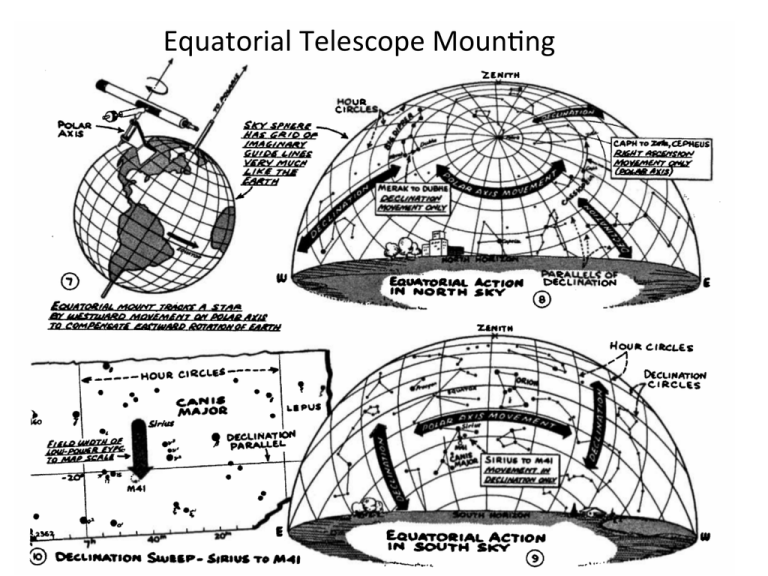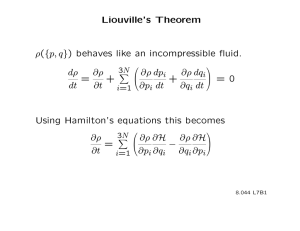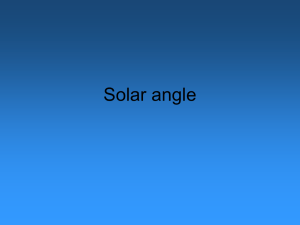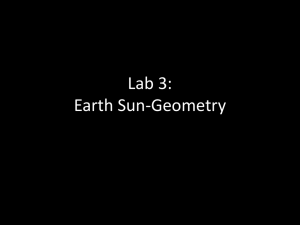Equatorial Telescope Moun2ng
advertisement

EquatorialTelescopeMoun2ng What’s wrong with this picture? OneSimpleConnec2on/Defini2on • ThecurrentSiderealTimeequalstheHourAngleoftheVernalEquinox http://www.polaris.iastate.edu/NorthStar/Unit4/unit4_sub2.htm Celestial Sphere Review AngularPerspec2ve • Equatorial and Local coordinates are all about measuring angles, whether it be relative to the horizon or between two objects on the sky. • Angles can be estimated crudely with anatomy. • A fist at arm’s length subtends about ten degrees. • Your little finger at arm’s length subtends about a degree • Try it out on the Moon (which subtends ½ degree). • Orion from top to bottom (Betelgeuse to Rigel) subtends about 15 degrees. TransformingfromR.A.,Dec,andHourAngleto Al2tudeandAzimuth GeometryonaSphere • Great circles on a sphere intersect at (spherical) angles. • The intersection of three great circles defines a spherical triangle (with a sum of interior angles greater than 180 degrees) • The sides lengths (a,b,c which are actually angles seen from the center of the sphere) and the intersection angles (A,B,C) are related by the formulae at right. Transforming between Hour Angle, Dec and Altitude/ Azimuth is just a matter of identifying the “sides” From Chromey Chapter 3 EquatorialtoAlt/AzConversion ● Thequan22esweknow:Hourangle(viaR.A.andsidereal2me),Declina2on,and La2tude–2sidesandoneinteriorangle.That’senoughtocalculatetheother quan22es. The Meridian H is hour angle a is altitude A is azimuth P is the equatorial pole Z is the zenith φ is the latitude δ is the declination Third side determined by 2 sides and their interior angle WhichWayistheEarthTurned:ApparentSolarTime • The direction on the celestial sphere toward which the Earth is turned at your location has everything to do with what is up in the sky. • The Sun is also an important factor as it obscures the stars when it is up. • Apparent Solar Time is literally that. Measure the position to be exact the Hour Angle and add 12) of the Sun in the sky to determine Earth's rotation angle relative to the Sun. Note: The Earth rotates and revolves around the Sun “counterclockwise” when viewed from the North Pole. Apparent/LocalSolarTimevs.MeanSolarTime • LocalSolarTimeissundial2me. – Noon=the2mewhentheSuncrossestheMeridian – BecauseoftheEarth’sellip2calorbit(moreexactlybecauseofthevarying angularspeedastheEarthmovesarounditsellip2calorbit–Kepler’s2ndLaw inac2on)the2meofSolarNoondriYsthroughouttheyear. • TheobliquityoftheEarthisalsoafactorinthisdriY. • MeanSolarTimeaveragesthedaylengththroughouttheyear. – Therearefourdatesduringtheyearwheremean=apparentsolar2me The Equation of Time – The offset between mean and apparent solar time MeanSolarTimeandTimeZones • ForeachdegreeoflongitudeyougowestontheEarththeMeanSolar Timeis4minutesearlier. • EverycityhasaslightlydifferentMeanSolarTimewhichledto modestchaosintheearlyrailroadera(60milesisaboutonedegree) From Popular Science, 1884 TimeZonesLocallyStandardizedTime …attheexpenseofoffseangsolarnoon …attheexpenseofoffseangsolarnoon ModernTimeKeeping ● ● ● Defineasecond:9,192,631,770cyclesofthehyperfinecesium-133 transi2on. BeatthatsecondwithoutfailandwithoutregardforwhichwaytheEarth isturned–Interna2onalAtomicTime(TAI)=physics2me Trackthevaria2onsinEarthrota2on–par2cularlythe2dalslowingdueto theMoon'storqueontheEarth.Keepa2methattracksEarthrota2on (UT1). – – ● ● ImplementbykeepingtrackofaTAI-UT1offset(orstretchthesecond). WhereasTAItracksactualsecondsasneededforphysics,theUT1isnotuniform. Putinastepcorrec2onwhenneededtoapproximateUT1towithina second-CoordinatedUniversalTime(UTC)–ourstandardof2me(for bejerorforworse) UT1/UTCdetermineshowtheEarthisturnedrela2vetotheSun.As astronomerswecareabouthowtheEarthisturnedrela2vetothestars. ● ● Sidereal2meisa2me-of-yeardependentoffsetfromUT1(althoughUTCisgood enoughandthebasisofmostcomputerandradiocontrolledclocks). However,tobepreciseyoumustalsoaccountforyourlongitudeoffsetfromthe 2mezonemeridian(75degreesforEasternTime,forexample)orfromGreenwich ifusingUTC. TransitTelescopes–MeasuringEarthRota2on/LST TransitTelescopes–MeasuringEarthRota2on/LST LST is the R.A. of the star currently crossing The Meridian Varia2oninEarthRota2on ● ● ● Therota2onrateoftheEarthchangesduetosolar/lunar2des, internalmo2ons,andshiYingofwaterandiceonthesurface. TheseconditselfispreciselyfixedthusUT1driYsrela2vetoTAI. Theseeffectsintegratetofullsecondsover1-2years. Varia2oninEarthRota2on ● ● ● Therota2onrateoftheEarthchangesdueto2des,internalmo2ons, andshiYingofwaterandiceonthesurface. TheseconditselfispreciselyfixedthusUT1driYsrela2vetoTAI. Theseeffectsintegratetofullsecondsover1-2years. TidesandtheSlowingofEarth'sRota2on • SincetheEarthspinsfasterthantheMoonorbitstheEarthtriesto dragits2dalbulgesoutoflinewiththeMoon – -theMoon,inturn,triestopullthembackintoalignment. -TheconsequenceisthatEarthrota2onisslowingandtheMoonisgeang fartherfromtheEarth. LeapSeconds • Sincethesecondisoffixeddura2onandtheEarth’srota2onrateis slowingUT1driYssteadilywithrespecttoTAI • ThisdriYismuchworsethannecessarybecausethe1956defini2on ofthesecondwasbasedonastronomicalmeasurementsfromthe mid1800’s(backwhentheEarthwasrota2ngfaster). – TheaverageslowingofEarth’srota2onperiodis1.4milliseconds/century – Westartedwithas“stale”second! LeapSeconds • AleapsecondisaddedwhenUT1andUTCgettobe>0.9soutof stepandonlyonJune30orDecember31.Ifneededonthatdaya 61stsecondgetsaddedtothelastminuteoftheUTday. Es2mateLSTatthecurrent2me • Sidereal2meatNOONontheSpringEquinoxis0hours. • Rightnowitis40minutesshortoflocalnoon • Thesiderealclockhasrun3m56secondsfastsincethespring equinox. • Actuallyforbejerprecisionnotethatthesidereal2meatnoonon theFallequinoxis12hours. – October21(30days),November21(31days),December21(30days), January21(31days)+14daystothepresentdate=136days. – Atnoonitwillbeabout12hours+136*3.93LST=20.908hours • Charlojesvilleisatlongitude78.5degrees–3.5degrees*4 minuteswestofthemeridian Calcula2ngAirmass ● Airmass,thenumberofatmosphericthicknesseslighttraversesonthewayfromthe startotheobserver,dependsonlyontheal2tudeofthetarget,a. The Meridian H is hour angle a is altitude A is azimuth P is the equatorial pole Z is the zenith φ is the latitude δ is the declination ZenithAngleandAirmass ● ● Thecomplementoftheal2tudeangle,the“zenithangle”,measures theangularsepara2onofastarfromthepointoverhead. – Astarthatisjustrisingorseanghasazenithangleofz=90. – Astaroverheadhasazenithangleofzero. The“airmass”ofastarmeasuresthenumberofatmospheric thicknessesastar'slightispassingthroughonitswaytotheobserver andequalsthesecantofthezenithangle. – Sincetheatmosphereajenuatesstarlight,knowingtheairmassiscri2cal toprecisionstellarphotometry. * horizon z altitude airmass = sec(z) = 1 / cos(z) one atmosphere AirmassFactsandFigures ● ● Astaratthezenithhasairmass=1 ● Astar45degreesfromthezenithhasairmass=1.41=1/cos(45) ● Astar30abovethehorizon,60degreesfromzenith,hasairmass=2=1/cos(60) Ingeneralastronomerstrytoconductobserva2onsasclosetothezenithas possibleandatworstatairmass~2. ● ● Starsareattheirsmallestairmasswhentheytransitthemeridian.Thisvaluedepends onlyonthestar’sdeclina2onandtheobserversla2tude. Astarwithdeclina2onequaltoyourla2tudepassesoverhead(minimumairmass=1) * horizon z altitude airmass = sec(z) = 1 / cos(z) one atmosphere PlaneParallelApproximatestheSphericalAtmosphere Verymuchnottoscale Angle c is the altitude Angle b is the zenith angle, z However,PlaneParallelisPlentyGoodEnough AirmassCurves Onemore2metopic-JulianDate ● ● Astronomersneedto2metagobserva2onsinaconvenientway sinceMonth/Day/Yeariscumbersome JulianDateisthenumberofdays(anddecimalfrac2onthereof) sincenoonJan1,4713B.C. ● ● ● TheJuliandatefor2016February411:00:00.0ESTisJD2457423.167 Nohh:mm:ss.s! Thisnumberisabitcumbersomeandearly(Sputnikera) computa2onsdidnotwanttowastestorageontheunnecessary leadingdigits. – – ModifiedJulianDateisJD–2400000.5 ● The2meaboveisMJD57422.667 Thesubtrac2onof0.5daysshiYsthestartofanMJDtomidnightrather thantheJuliandaystartatnoon SunriseSunset ● Factorsinfluencingsunrise/sunset2me – youtellme....What2medoestheSunsetontheSpringEquinox?it'snot 6:00p.m.... Recall Celestial Motion at Different Declinations Celestial equator (circumpolar) When the Sun lies on the celestial equator days are 12 hours long The Sun can get as far as +/- 23.5 degrees from the celestial equator in declination. A graphical view of Sunset throughout the year. Sunrise/Sunset • The equation of time skews the symmetry of sunrise and sunset. • In the northern hemisphere the earliest sunset is around December 5 (not 21!) and the sun rapidly returns to the evening sky. • The latest sunrise happens around January 4. Twilight(s) ● ● TwilightistheeffectoftheSunshiningontheatmospherewhile thediskoftheSunisbelowthehorizon. AstheSunsinkslowerbelowthehorizonsuccessivelyhigher/ thinnerlayersoftheatmosphereareilluminated.




